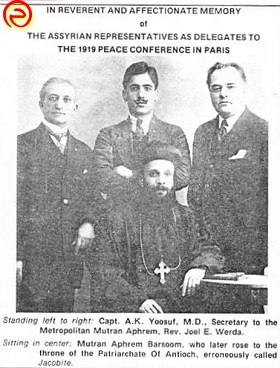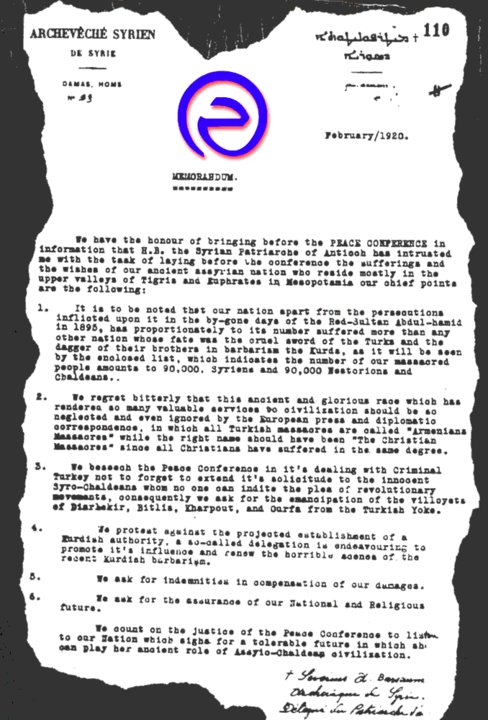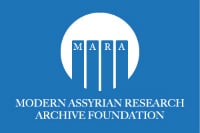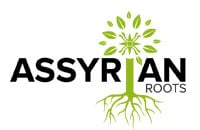By: Afram Barryakoub
Note: Map of the territory over which the Assyrians demanded during the Paris Peace Conference in 1919
Assyrians today demand autonomy in a small part of northern Iraq. But 88 years ago, the Assyrian demands were considerably more extensive. Then the requirement was of a free and independent Assyria, which also extended over large areas.
Most Assyrians have previously not seen the map above. It has been found in the Vatican's secret archives. The Assyrian writer and book collector Beth Şawoce recently got hold of the map during his visit to the Vatican archives. It shows the area of land Assyrians claimed after the First World War.
In 1919 delegations gathered from several countries to sort out compensation claims and determine new requirements on countries that lost during the First World War. Another important element in the negotiations was to redraw the boundaries and dismember the remnants of the Ottoman Empire. The conference was held in Paris and has therefore been named the Paris peace conference 1919th
The Assyrians had to endure considerable strain during the First World War. Turks and Kurds genocide against the Assyrians had major consequences. The small nation was decimated strongly and in some places eradicated altogether. But still the Assyrians played an important and often overlooked role in the great World War. By allying itself with the Western powers and Russia the Assyrians succeeded to save some of their people from downfall.
Britain was during the war years in great need of isolating the Turks from reaching certain strategic points along the Turkish-Persian border, areas where Assyrians lived. Therefore the British promised to fulfill the old dream of an independent Assyria as soon as the war was over if the Assyrians helped. The Assyrians saw this as its chance for liberation from the approximately 2,600-year oppression of neighboring nations. Armed by Britain a small Assyrian army under the leadership of Agha Peter D'Baz took on the regular Turkish army and the Kurdish clans. During several battles the Turkish army and the Kurdish clans were fought back. Agha Petrus was honored by the British as a great strategist.
When the World War ended, the Assyrians delegations prepared to go and represent the interests of the Assyrians during the Paris Peace Conference. The requirements were shaped and a map of Assyria was developed to be presented to the great powers. But the Assyrian delegation didn't come far. The British government did everything in its power to prevent the Assyrian delegation from speaking at the conference. The promise of a free and independent Assyria turned out to be just empty words. Other interests, like oil, weighed much heavier for the British than their promises to the Assyrian nation. The map above never got to see the light of day. Instead, countries such as Syria, Iraq and Turkey were formed on top of it today occupied Assyria.
Today, the Assyrians are a hot target for Islamists in Iraq. They abducts, rape, behead, threaten, oppress, forcing to escape and manipulates the Assyrians from both Arab and Kurdish sides. Ethnic cleansing in other words. To protect themselves the Assyrians now require autonomy in a limited area of Assyria (northern Iraq). Western powers have not yet given any promises and the UK, which now has a historic opportunity to restore its honor by helping the Assyrians, pretend as nothing. Despite this, the question of Assyria is relevant today as 88 years ago, regardless of promises or interest from major powers.
Note: The Assyrian delegation (whom Syriac Orthodox Bishop Mor Afram Barsom [and later Patriarch] was part off) at the League of Nations in Paris, in 1919-1920.
Note: Document from Paris Peace Conference in 1920, the intro reads: "We have the honour of bringing before the Peace Conference in information that H.B. the Syrian Patriarche of Antioch has intrusted me with the task of laying before the conference the sufferings and the wishes of our ancient assyrian nation who reside mostly in the upper valleys of Tigris and Euphrates in Mesopotamia our chief points are the following"
Note: The Assyrian delegates to the Peace Conference in Paris, 1919. The flag with the 3 layers was the first Assyrian flag. On the top left of the first layer, 3 white stars represented the three main Churches of the Assyrian people: Church of the East, Chaldean Catholic Church, and Syriac Orthodox Church (it is also used by members of the Syriac Catholic Church). This flag was used during delegation meetings with Assyrian politicians and Western powers during and post World War I. The flag was used until the current design was established. The flag was created by the Syriac Orthodox community of Tur Abdin






